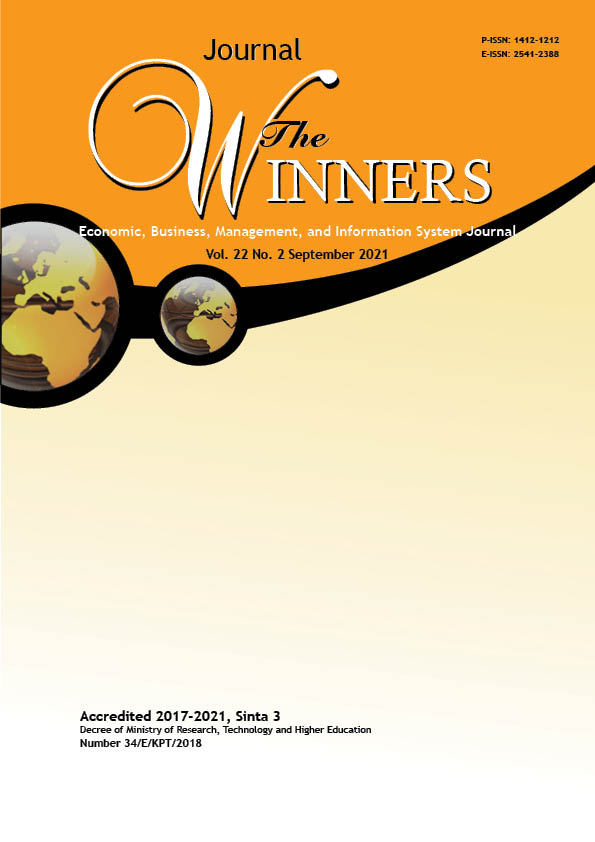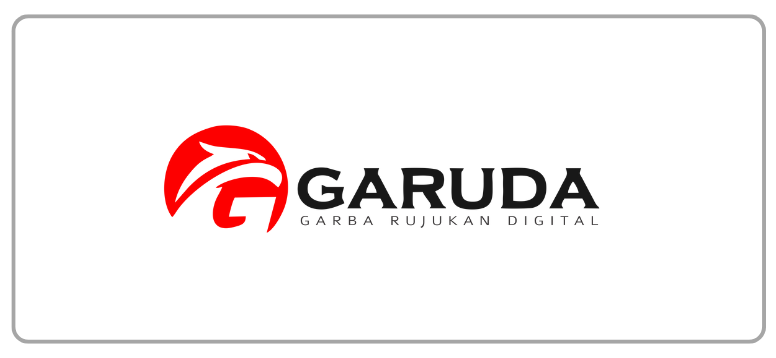Using Social Media Marketing to Create Brand Awareness, Brand Image, and Brand Loyalty on Tourism Sector in Indonesia
DOI:
https://doi.org/10.21512/tw.v22i2.7597Keywords:
social media marketing, consumer brand engagement, brand loyalty, brand awareness, brand imageAbstract
The research aimed to examine factors that formed brand awareness and brand image of the tourism sector in Indonesia by using social media marketing on TikTok platform. The research applied a quantitative method to do a survey of 220 respondents who were users of the TikTok application. Data collection was carried out from April to May 2021, and processed by using Structural Equation Model Partial Least Square (SEM PLS). Convenience sampling was used in the research. The results show that entertainment, electronic word of mouth, and interaction positively affect consumer brand engagement. Trendiness and customization do not affect consumer brand engagement. Furthermore, it is found that consumer brand engagement positively affects brand loyalty, brand awareness, and brand image. The implication of the research is a reference for managers and policymakers in formulating strategies to improve the tourism sector in Indonesia using the model Social Media Marketing on TikTok.
References
Barger, V., Peltier, J. W., & Schultz, D. E. (2016). Social media and consumer engagement: a review and research agenda. Journal of Research in Interactive Marketing, 10(4), 268-287. https://doi.org/10.1108/JRIM-06-2016-0065.
Bilgin, Y. (2018). The effect of social media marketing activities on brand awareness, brand image and brand loyalty. Business & Management Studies: An International Journal, 6(1), 128-148. https://doi.org/10.15295/bmij.v6i1.229.
Bresnick, E. (2019). Intensified play: cinematic study of TikTok mobile app. University of Southern California, 4(4), 1-12.
Brodie, R. J., Ilic, A., Juric, B., & Hollebeek, L. (2013). Consumer engagement in a virtual brand community: An exploratory analysis. Journal of Business Research, 66(1), 105-114. https://doi.org/10.1016/j.jbusres.2011.07.029.
Cahyani, K. I. & Sutrasmawati, E. (2016). Pengaruh brand awareness dan brand image terhadap keputusan pembelian. Management Analysis Journal, 5(4), 281-288. https://doi.org/10.15294/maj.v5i4.8350.
Chahal, H. & Rani, A. (2017). How trust moderates social media engagement and brand equity. Journal of Research in Interactive Marketing, 11(3), 312-335. https://doi.org/10.1108/JRIM-10-2016-0104.
Cheung, M. L., Pires, G., & Rosenberger, P. J. (2020). The influence of perceived social media marketing elements on consumer–brand engagement and brand knowledge. Asia Pacific Journal of Marketing and Logistics, 32(3), 695-720. https://doi.org/10.1108/APJML-04-2019-0262.
Dessart, L., Veloutsou, C., & Morgan-Thomas, A. (2015). Consumer engagement in online brand communities: A social media perspective. Journal of Product and Brand Management, 24(1), 28-42. https://doi.org/10.1108/JPBM-06-2014-0635.
Dwivedi, A. (2015). A higher-order model of consumer brand engagement and its impact on loyalty intentions. Journal of Retailing and Consumer Services, 24(C), 100-109. https://doi.org/10.1016/j.jretconser.2015.02.007.
Fernandes, T. & Moreira, M. (2019). Consumer brand engagement, satisfaction and brand loyalty: A comparative study between functional and emotional brand relationships. Journal of Product and Brand Management, 28(2), 274-286. https://doi.org/10.1108/JPBM-08-2017-1545.
Gallaugher, J. & Ransbotham, S. (2010). Social media and customer dialog management at Starbucks. A framework for analyzing social-media-based customer dialog. MIS Quarterly Executive, 9(4), 197-212.
Genadi, Y. D. & Furkan, L. M. (2020). Pengaruh informativeness, entertainment, dan irritating terhadap attitude toward social media advertising pada masyarakat Kota Mataram. Jurnal Magister Manajemen, 9(2), 186. https://doi.org/10.29303/jmm.v9i2.538.
Gvili, Y. & Levy, S. (2018). Customer engagement with eWOM on social media: The role social capital. Online Information Review, 24(4), 482-505. https://doi.org/10.1108/OIR-05-2017-0158.
Hair, Jr., J. F., Hult, G. T. M., Ringle, C. M. & Sarstedt, M. (2017). A Primer on Partial Least Squares Structural Equation Modelling (PLS-SEM) (2nd Ed.). Los Angeles: SAGE Publications, Inc.
Janadari, M. P. N., Ramalu, S. S., & Wei, C. C. (2018). Evaluation of measurment and structural model of the reflective model constructs in PLS-SEM. The Sixth (6th) International Symposium of South Eastern University of Sri Lanka, 187-194.
Kandampully, J., Zhang, T., & Bilgihan, A. (2015). Customer loyalty: A review and future directions with a special focus on the hospitality industry. International Journal of Contemporary Hospitality Management, 27(3), 379-414. https://doi.org/10.1108/IJCHM-03-2014-0151.
Keller, K. L. (2010). Brand equity management in a multichannel, multimedia retail environment. Journal of Interactive Marketing, 24(2), 58-70. https://doi.org/10.1016/j.intmar.2010.03.001.
Khan, I., Rahman, Z., & Fatma, M. (2016). The role of customer brand engagement and brand experience in online banking. International Journal of Bank Marketing, 34(7), 1025-1041. https://doi.org/10.1108/IJBM-07-2015-0110.
Langaro, D., Rita, P., & de Fátima Salgueiro, M. (2018). Do social networking sites contribute for building brands? Evaluating the impact of users’ participation on brand awareness and brand attitude. Journal of Marketing Communications, 24(2), 146-168. https://doi.org/10.1080/13527266.2015.1036100.
Liu, F., Li, J., Mizerski, D., & Soh, H. (2012). Self-congruity, brand attitude, and brand loyalty: A study on luxury brands. European Journal of Marketing, 46(7), 922-937. https://doi.org/10.1108/03090561211230098.
Liu, X., Shin, H., & Burns, A. C. (2021). Examining the impact of luxury brand’s social media marketing on customer engagement: Using big data analytics and natural language processing. Journal of Business Research, 125, 815-826. https://doi.org/10.1016/j.jbusres.2019.04.042.
Mileva, L. & Fauzi DH, A. (2018). Pengaruh social media marketing terhadap keputusan pembelian (survei online pada mahasiswa sarjana jurusan Ilmu Administrasi Bisnis Angkatan 2014/2015 Fakultas Ilmu Administrasi Universitas Brawijaya yang Membeli Starbucks. Jurnal Administrasi Bisnis (JAB), 58(1), 190-199.
Nasution, M. I., Fahmi, M., Jufrizen, Muslih, & Prayogi, M. A. (2020). The quality of small and medium enterprises performance using the Structural Equation Model-Part Least Square (SEM-PLS). Journal of Physics: Conference Series, 1477(5). https://doi.org/10.1088/1742-6596/1477/5/052052.
Patterson, P., Yu, T., & de Ruyter, K. (2006). Understanding customer engagement in services. Proceedings of ANZMAC 2006 Conference, 1-47.
Perkembangan pariwisata Juli 2020. (2020). Badan Pusat Statistik (BPS). https://www.bps.go.id/website/images/Pariwisata-Rilis-September-2020-ind.jpg
Putra, A. R. A. & Mudiantono. (2014). Analisis pengaruh daya tarik pesan iklan, persepsi kemanfaatan, citra merek pada media sosial Twitter terhadap pembentukan brand awareness (Studi kasus pada media sosial Twitter @infoUNDIP atau Info Undip Media). Diponegoro Journal of Management, 3(3), 1-12.
Rahman, I. A., Memon, A. H., & Karim, A. T. A. (2013). Examining factors affecting budget overrun of construction projects undertaken through management procurement method using PLS-SEM approach. Procedia - Social and Behavioral Sciences, 107, 120-128. https://doi.org/10.1016/j.sbspro.2013.12.407.
Seo, E-J. & Park, J-W. (2018). A study on the effects of social media marketing activities on brand equity and customer response in the airline industry. Journal of Air Transport Management, 66(C), 36-41. https://doi.org/10.1016/j.jairtraman.2017.09.014.
Su, Y., Baker, B. J., Doyle, J. P., & Yan, M. (2020). Fan engagement in 15 seconds: Athletes’ relationship marketing during a pandemic via TikTok. International Journal of Sport Communication, 13(3), 436-446. https://doi.org/10.1123/ijsc.2020-0238.
UNWTO. (2021). UNWTO World Tourism Barometer. https://doi.org/10.18111/wtobarometereng.
Downloads
Published
How to Cite
Issue
Section
License
Copyright (c) 2021 Santi Rimadias

This work is licensed under a Creative Commons Attribution-ShareAlike 4.0 International License.
Authors who publish with this journal agree to the following terms:
a. Authors retain copyright and grant the journal right of first publication with the work simultaneously licensed under a Creative Commons Attribution License - Share Alike that allows others to share the work with an acknowledgment of the work's authorship and initial publication in this journal.
b. Authors are able to enter into separate, additional contractual arrangements for the non-exclusive distribution of the journal's published version of the work (e.g., post it to an institutional repository or publish it in a book), with an acknowledgment of its initial publication in this journal.
c. Authors are permitted and encouraged to post their work online (e.g., in institutional repositories or on their website) prior to and during the submission process, as it can lead to productive exchanges, as well as earlier and greater citation of published work.
USER RIGHTS
All articles published Open Access will be immediately and permanently free for everyone to read and download. We are continuously working with our author communities to select the best choice of license options, currently being defined for this journal as follows: Creative Commons Attribution-Share Alike (CC BY-SA)

















